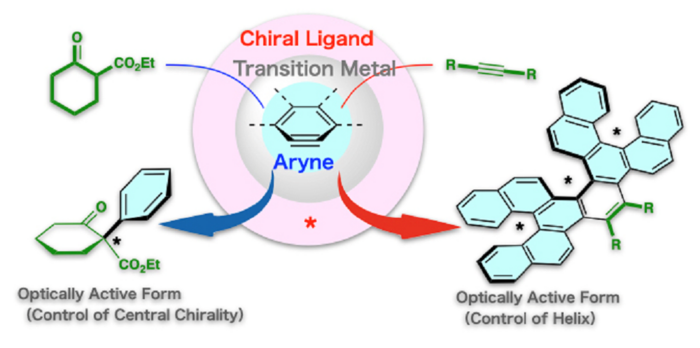Arynes, synthetic intermediates in which a portion of the benzene ring is a triple bond, have been applied in various organic molecular transformations and have long been of interest to chemists as extremely useful compounds. Furthermore, with the advancement in aryne chemistry, the development of “asymmetric synthesis” reactions of arynes, which are expected to increase the efficiency of the synthesis of compounds with complex steric structures and facilitate the creation of new compounds, has attracted increasing attention.

Credit: Ken Kamikawa, OMU
Arynes, synthetic intermediates in which a portion of the benzene ring is a triple bond, have been applied in various organic molecular transformations and have long been of interest to chemists as extremely useful compounds. Furthermore, with the advancement in aryne chemistry, the development of “asymmetric synthesis” reactions of arynes, which are expected to increase the efficiency of the synthesis of compounds with complex steric structures and facilitate the creation of new compounds, has attracted increasing attention.
However, asymmetric synthesis based on arynes, which are extremely reactive and unstable, presents several challenges. Therefore, asymmetric reactions that can realize high stereoselectivity of arynes need to be developed.
Ken Kamikawa, Professor at the Graduate School of Science, Osaka Metropolitan University, published a review article on numerous asymmetric reactions based on arynes, organized by style, and detailed their outline and characteristics. Unresolved issues and prospects in this field are also described.
“Asymmetric synthesis using arynes is an unexplored field with many possibilities,” stated Professor Kamikawa. “In the future, many researchers will enter this field, and their expertise and creativity will greatly expand the potential of asymmetric synthesis for developing pharmaceuticals and materials.”
###
About OMU
Osaka Metropolitan University is a new public university established by a merger between Osaka City University and Osaka Prefecture University in April 2022. For more science news, see https://www.omu.ac.jp/en/, and follow @OsakaMetUniv_en, or search #OMUScience.
Journal
Nature Reviews Chemistry
DOI
10.1016/j.eti.2023.103093
Method of Research
Experimental study
Subject of Research
Not applicable
Article Title
Asymmetric reactions involving aryne intermediates
Article Publication Date
31-Mar-2023




